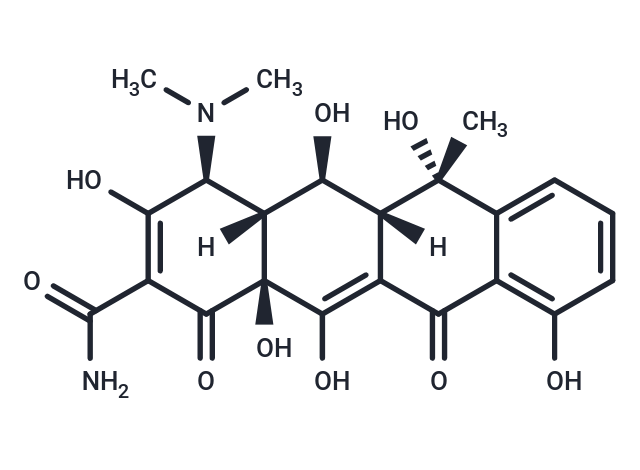Shopping Cart
Remove All Your shopping cart is currently empty
Your shopping cart is currently empty
Oxytetracycline (Terramycin) is a TETRACYCLINE analog isolated from the actinomycete STREPTOMYCES rimosus and used in a wide variety of clinical conditions.

| Pack Size | Price | USA Warehouse | Global Warehouse | Quantity |
|---|---|---|---|---|
| 50 mg | $35 | In Stock | In Stock | |
| 100 mg | $52 | In Stock | In Stock | |
| 500 mg | $139 | In Stock | In Stock | |
| 1 g | $198 | In Stock | In Stock | |
| 1 mL x 10 mM (in DMSO) | $39 | In Stock | In Stock |
| Description | Oxytetracycline (Terramycin) is a TETRACYCLINE analog isolated from the actinomycete STREPTOMYCES rimosus and used in a wide variety of clinical conditions. |
| In vivo | Oxytetracycline (200 mg/kg for 15 days) results a significant elevation in serum hepatospecific markers such as aspartate transaminase, alanine transaminase, alkaline phosphatase, lactate dehydrogenase, and bilirubin and the levels of lipid peroxidation markers (thiobarbituric acid reactive substances (TBARS) and lipid hydroperoxides) in rat liver. Oxytetracycline also causes a significant reduction in the activities of superoxide dismutase, catalase, glutathione peroxidase, reduced glutathione (GSH), vitamin C and vitamin E in rat liver. Oxytetracycline (200 mg/kg) combined with Naringenin (50 mg/kg b.w.t.) significantly decreases the activities of serum aspartate transaminase, alanine transaminase, alkaline phosphatase, lactate dehydrogenase and the levels of bilirubin along with significant decrease in the levels of lipid peroxidation markers in the rat liver. [1] Oxytetracycline (200 mg/kg, oral for 15 days) produces hepatic damage as manifested by a significant increase in serum hepatic markers namely aspartate transaminase (AST), alanine transaminase (ALT), alkaline phosphatase (ALP), lactate dehydrogenase (LDH), bilirubin and increases plasma and hepatic lipid peroxidation indices (TBARS and hydroperoxide) in rats. Oxytetracycline significantly decreases the levels of enzymatic antioxidants namely superoxide dismutase (SOD), catalase (CAT) and glutathione peroxidase (GPx). [2] |
| Synonyms | Terramycin |
| Molecular Weight | 460.43 |
| Formula | C22H24N2O9 |
| Cas No. | 79-57-2 |
| Smiles | [H][C@@]12[C@@H](O)[C@@]3([H])C(C(=O)c4c(O)cccc4[C@@]3(C)O)=C(O)[C@]1(O)C(=O)C(C(N)=O)=C(O)[C@H]2N(C)C |
| Relative Density. | 1.634 g/cm3 (20°C) |
| Color | Transparent |
| Appearance | Solid |
| Storage | Powder: -20°C for 3 years | In solvent: -80°C for 1 year | Shipping with blue ice/Shipping at ambient temperature. | ||||||||||||||||||||||||||||||||||||||||
| Solubility Information | DMSO: 90 mg/mL (195.47 mM), Sonication is recommended. Ethanol: 10 mg/mL (21.72 mM), Sonication is recommended. | ||||||||||||||||||||||||||||||||||||||||
| In Vivo Formulation | 10% DMSO+40% PEG300+5% Tween 80+45% Saline: 3.3 mg/mL (7.17 mM), Sonication is recommended. Please add the solvents sequentially, clarifying the solution as much as possible before adding the next one. Dissolve by heating and/or sonication if necessary. Working solution is recommended to be prepared and used immediately. The formulation provided above is for reference purposes only. In vivo formulations may vary and should be modified based on specific experimental conditions. | ||||||||||||||||||||||||||||||||||||||||
Solution Preparation Table | |||||||||||||||||||||||||||||||||||||||||
Ethanol/DMSO
DMSO
| |||||||||||||||||||||||||||||||||||||||||
| Size | Quantity | Unit Price | Amount | Operation |
|---|

Copyright © 2015-2025 TargetMol Chemicals Inc. All Rights Reserved.